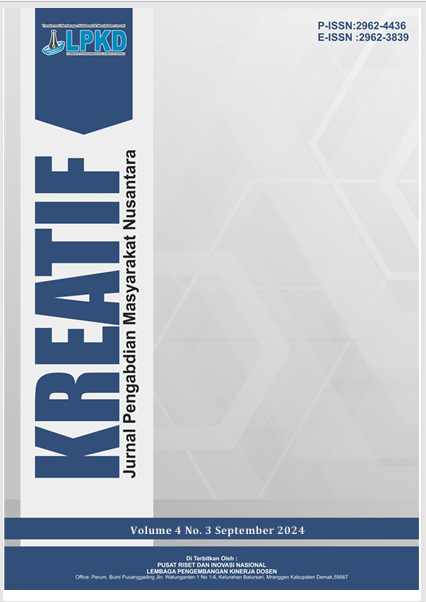Pelatihan Pemanfaatan E-learning Moodle dalam Mengeksplorasi Asynchronous Learning di MA Diniyah Putri Pekanbaru
DOI:
https://doi.org/10.55606/kreatif.v5i1.8170Keywords:
Asynchronous Learning, Community Service, E-Learning, Moodle, Teacher TrainingAbstract
The Community Service Program (PkM) implemented at MA Diniyyah Putri Pekanbaru aimed to improve teachers' capacity in utilizing the Moodle Learning Management System (LMS) as a learning tool, particularly in implementing asynchronous learning models. This activity employed a participatory approach with three core stages: planning, implementation, and evaluation. During the planning stage, the implementation team conducted observations and interviews to identify teachers' needs and challenges in using learning technology. The implementation stage then focused on delivering materials, hands-on practice using Moodle, and intensive mentoring in designing asynchronous learning content tailored to students' needs. Evaluation of the program was conducted through a questionnaire with 20 participating teachers, which provided an overview of the training's effectiveness. The results showed a significant improvement in teachers' abilities in compiling digital materials, managing virtual classes, giving assignments, and monitoring students' online learning activities. Teachers also began to be able to design asynchronous learning that was more interactive and flexible, and encouraged students' independent learning. Another visible impact was the increased creativity of teachers in utilizing Moodle features to support distance learning. These findings align with previous studies that emphasize Moodle's superiority in supporting digital learning while strengthening the professionalism of educators. This training is expected to foster a relevant and sustainable technology-based professional development model, particularly in Islamic boarding schools and similar educational institutions. This will enable teachers to be more adaptable to the challenges of the digital era and able to provide meaningful learning experiences for students. These findings align with previous studies that emphasize Moodle's superiority in supporting distance learning and enhancing teacher creativity. This training is expected to serve as a model for technology-based teacher professional development in Islamic boarding schools and similar educational institutions.
References
Aljawarneh, S. A. (2020). Reviewing and exploring innovative ubiquitous learning tools in higher education. Journal of Computing in Higher Education, 32(1), 57–73. https://doi.org/10.1007/s12528-019-09207-0
Arifin, F., Ulfiana, E., & Admojo, W. (2021). Optimalisasi platform digital dalam pembelajaran daring di tengah pandemi COVID-19. Jurnal Pendidikan Terbuka dan Jarak Jauh, 21(1), 23–32. https://doi.org/10.33830/ptjj.v22i2.1917.2021
Asmiyunda, A., Sanova, A., & Ekaputra, F. (2023). Pelatihan pemanfaatan aplikasi platform open course berbasis Moodle dalam mengelola pembelajaran daring. Jurnal Pengabdian UNDIKMA, 4(2), 362–370. https://doi.org/10.33394/jpu.v4i2.7216
Batubara, H. H. (2018). Pelatihan e-learning berbasis Moodle untuk dosen-dosen Universitas Islam Kalimantan Mab Banjarmasin. JCES (Journal Character Education Society), 1(1), 57–66. https://doi.org/10.31764/jces.v1i1.115
Boelens, R., De Wever, B., & Voet, M. (2017). Four key challenges to the design of blended learning: A systematic literature review. Educational Research Review, 22, 1–18. https://doi.org/10.1016/j.edurev.2017.06.001
Handayani, S. G., & W., W. (2022). Penggunaan learning management system Moodle pada penilaian akhir semester di SMKN 3 Kota Solok. Jurnal Pendidikan Tambusai, 8(1), 1–10. https://doi.org/10.31004/jptam.v8i1.12896
Herayanti, L., Habibi, H., & Fuaddunnazmi, M. (2017). Pengembangan media pembelajaran berbasis Moodle pada mata kuliah Fisika Dasar. Jurnal Pendidikan Fisika dan Teknologi, 1(3), 205–209. https://doi.org/10.29303/jpft.v1i3.260
Jensen, J., Smith, C. M., Bowers, R., Kaloi, M., Ogden, T. H., Parry, K. A., Payne, J. S., & Holt, E. (2022). Asynchronous online instruction leads to learning gaps when compared to a flipped classroom. Journal of Science Education and Technology, 31(6), 718–729. https://doi.org/10.1007/s10956-022-09988-7
Mayer, R. E. (2019). How multimedia can improve learning and instruction. Cambridge University Press. https://doi.org/10.1017/9781108235631.019
Mayer, R. E. (2021). Evidence-based principles for how to design effective instructional videos. Journal of Applied Research in Memory and Cognition, 10(2), 229–240. https://doi.org/10.1016/j.jarmac.2021.03.007
Rahmadansah, R., Haryanto, H., Sanova, A., Asrial, A., Yusnidar, Y., & Raidil, M. (2022). Pengaruh model pembelajaran Tai berbantuan e-LKPD interaktif terhadap kemampuan berpikir kritis siswa materi asam basa. Jurnal Zarah, 10(1), 38–46. https://doi.org/10.31629/zarah.v10i1.4252
Raza, S. A., Qazi, W., Khan, K., & Salam, J. (2021). Social isolation and acceptance of the learning management system (LMS) in the time of COVID-19 pandemic: An expansion of the UTAUT model. Journal of Educational Computing Research, 59(2), 183–208. https://doi.org/10.1177/0735633120960421
Satriani, E. (2021). E-learning Moodle: Design and development model of intensive reading. Linguistics and Culture Review, 5(S2), 1521–1532. https://doi.org/10.21744/lingcure.v5nS2.2010
Satriani, E., Wahyuni, S., & Muklis, M. (2023). Pelatihan desain konten pembelajaran yang kreatif dan inovatif berbasis aplikasi Moodle. Jurnal Pengabdian UNDIKMA, 4(1), 74–82. https://doi.org/10.33394/jpu.v4i1.6866
Sembiring, D. A. K., Risamasu, P. E. G., Tijow, M. A., Aryesam, A., Sogalrey, F. A. M., Karim, A., Selfe, S., Rosiyanti, R., & Rafra, J. A. (2024). Pelatihan desain media pembelajaran inovatif berbasis platform Canva bagi guru SMP Negeri 1 Depapre Kabupaten Jayapura. Jurnal Pengabdian UNDIKMA, 5(2), 264–272. https://doi.org/10.33394/jpu.v5i2.10854
Downloads
Published
How to Cite
Issue
Section
License
Copyright (c) 2025 KREATIF: Jurnal Pengabdian Masyarakat Nusantara

This work is licensed under a Creative Commons Attribution-ShareAlike 4.0 International License.








